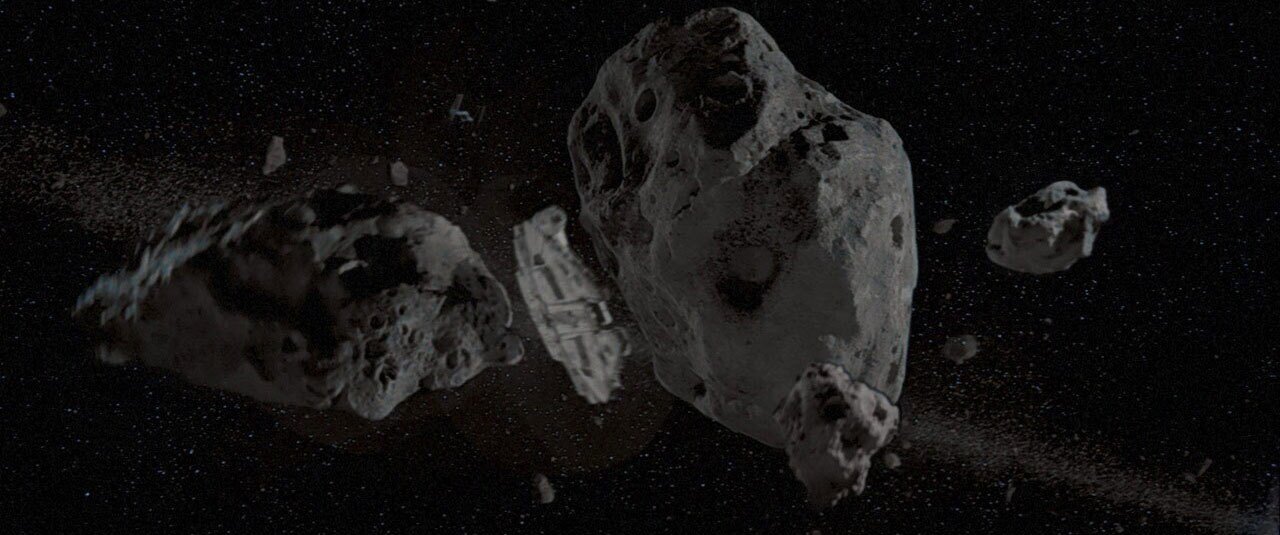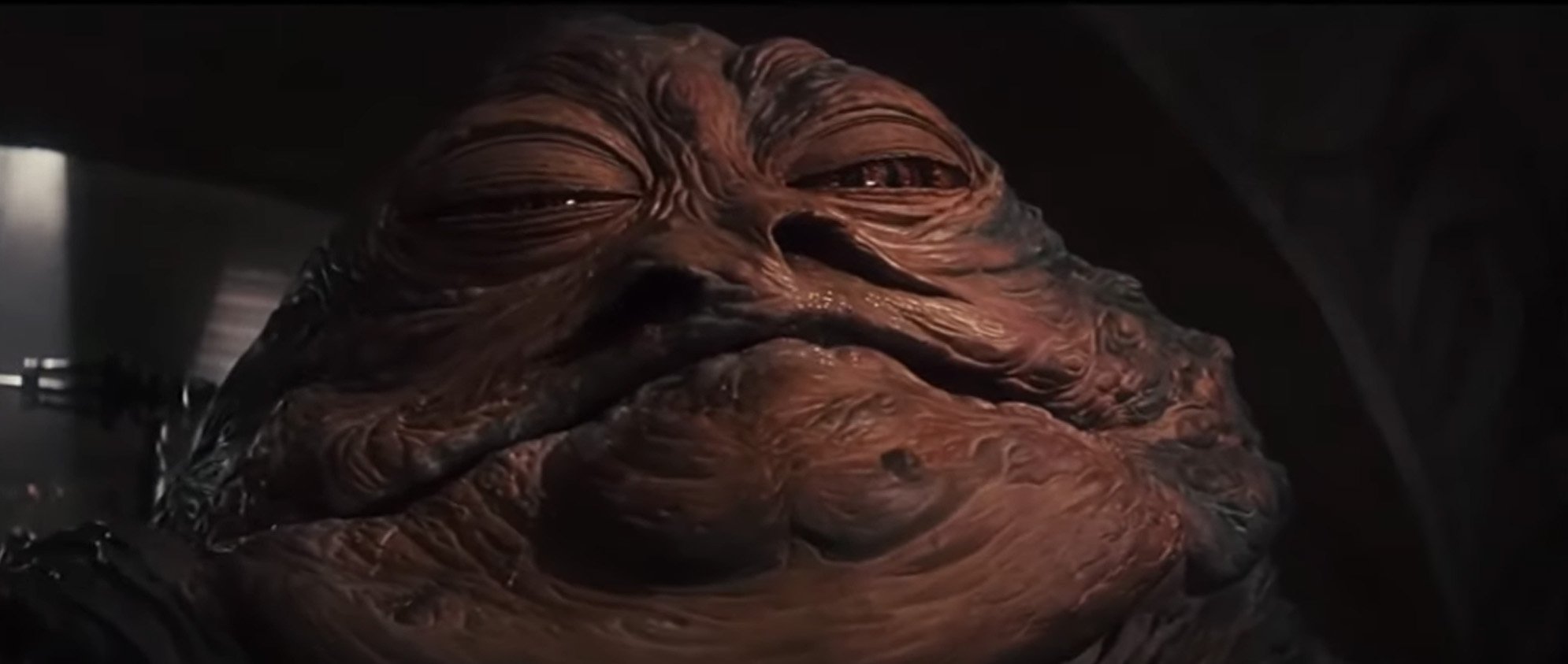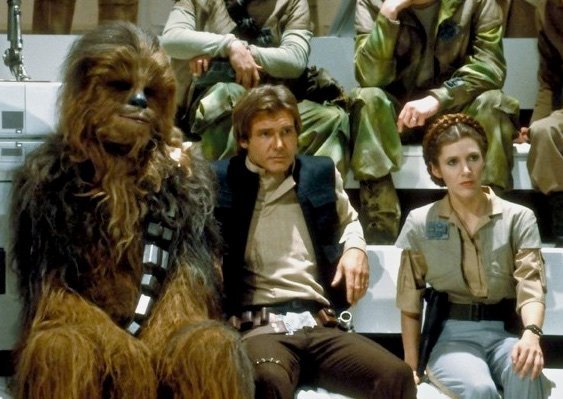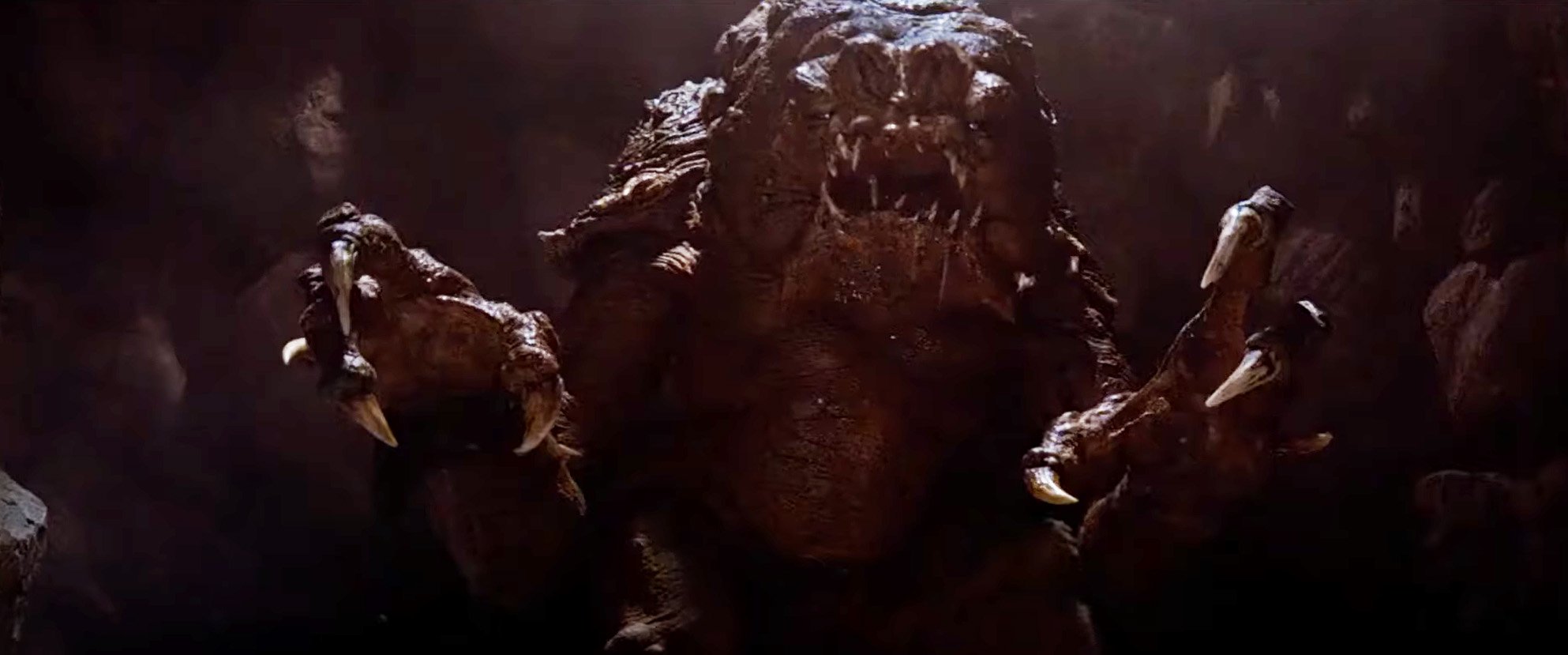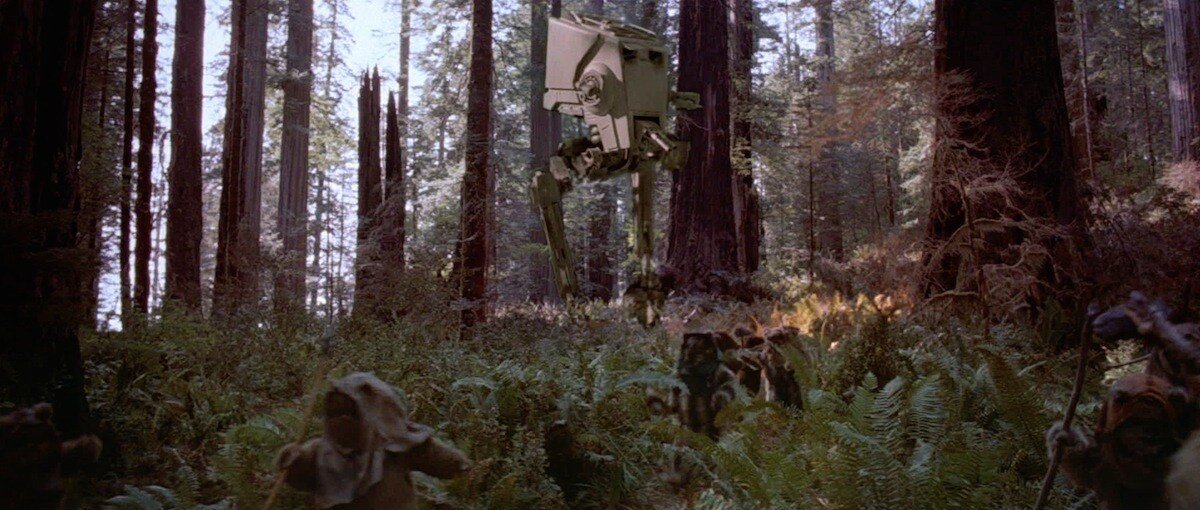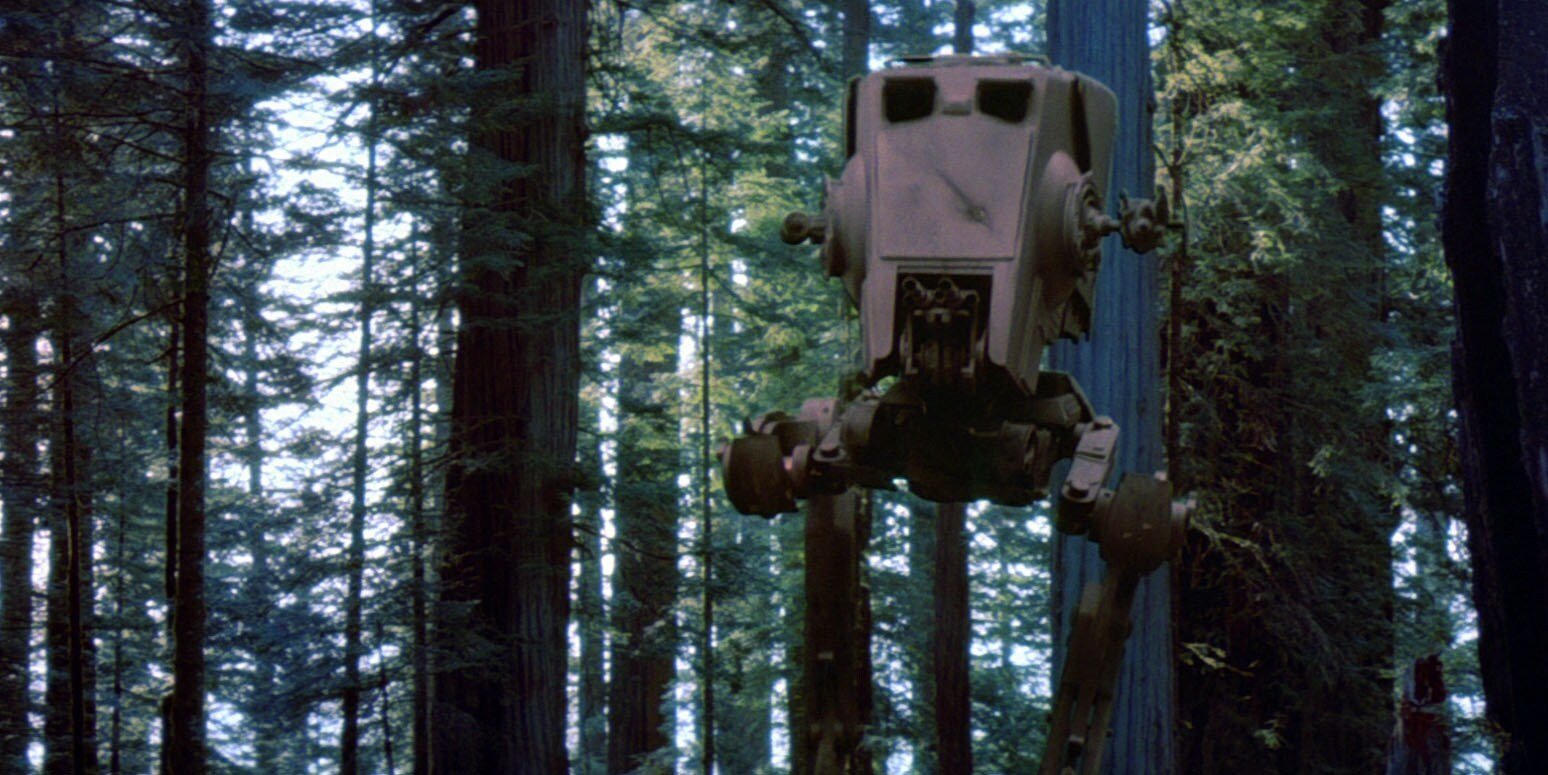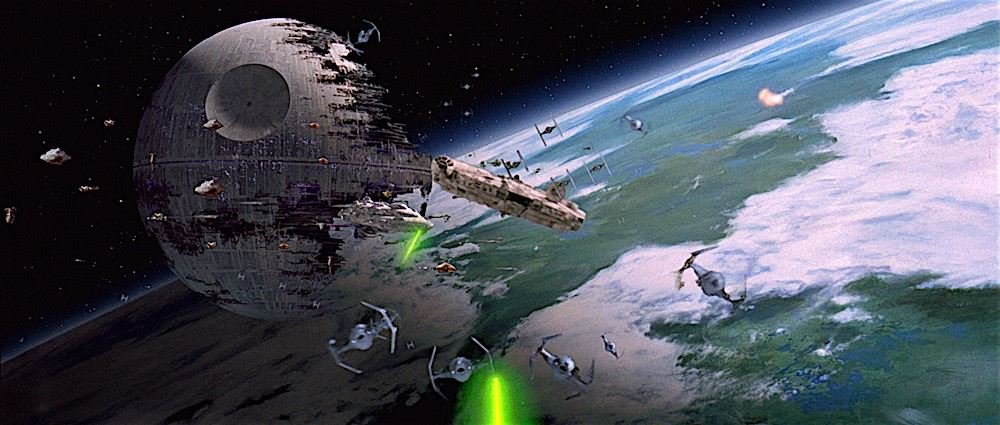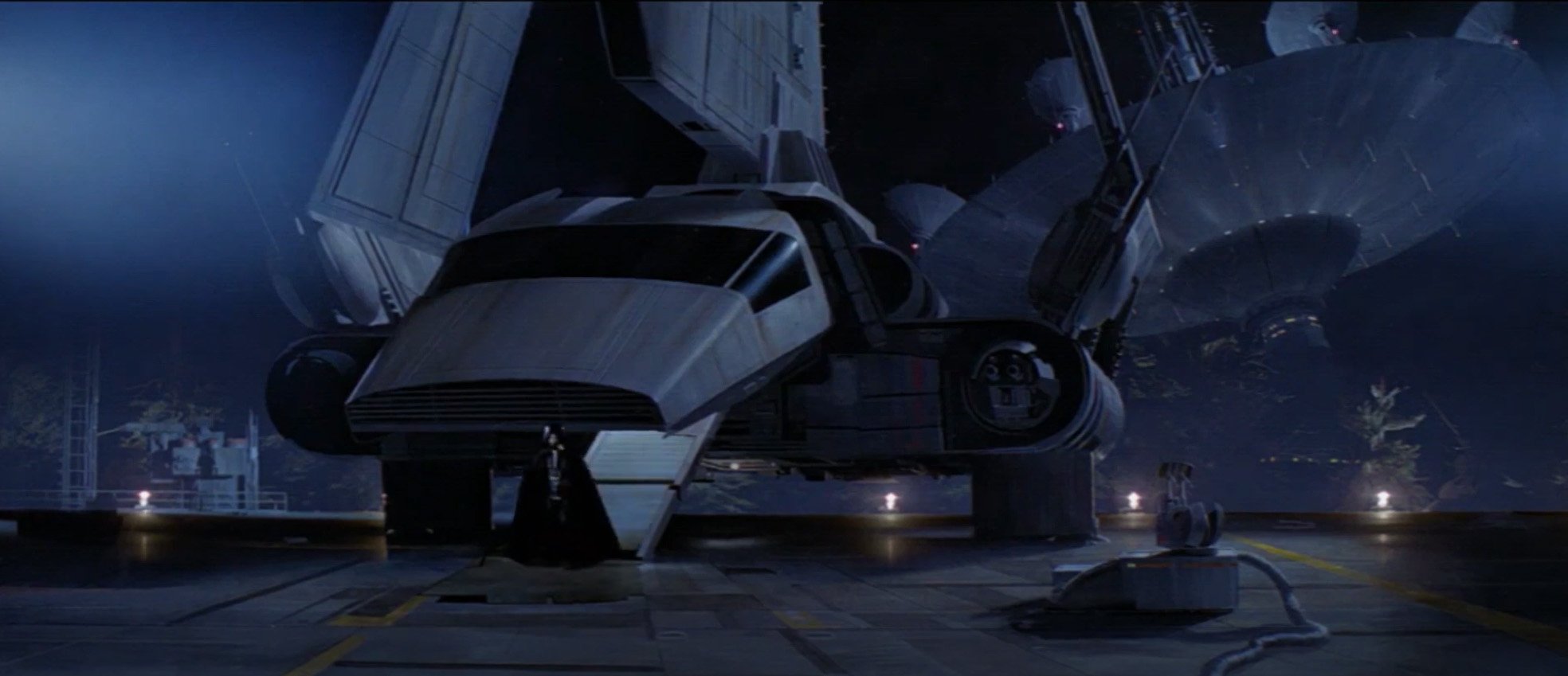RETURN OF THE JEDI
The Greatest VIsual Effects Film Ever Made
Matthew Teevan May 25th 2023 (updated May 2025)
RETURN OF THE JEDI is for me the greatest visual effects movie ever made – something I have felt since I first saw it 40 years ago when it was released. So, I thought the 40th Anniversary was a good time to write about it.
The period from the late 1970s to the mid-1980s was an incredible period of imagination and technical virtuosity. Huge advances were made from ‘Star Wars’ to ‘Return of the Jedi’. Films like ‘Dragonslayer’ and ‘Star Trek II’ and of course ‘The Empire Strikes Back’ all broke new ground. ‘Return of the Jedi’ was able to benefit from all of this and the vfx team could by and large put all of their time and energy into the shots themselves. For me this film contains the best visual effects ever put on film.
I have previously written a blog – ‘What makes the special visual effects in STAR WARS so special’ Which lays out the baseline that helped to distinguish that film. The development and advance in Motion Control, Vista Vision and Optical Compositing and Miniatures.
https://www.matteline.com/blog-why-the-special-effects-of-star-wars-are-so-special
The Space Battle is just one of several awesome and spectacular scenes in the film. The Speeder Bike Chase, the Attack on the Death Star, the Forest Battle, Luke’s escape from Jabba the Hutt. Any one of these scenes would make the film memorable and worthy of a spot in the VFX hall of fame. I knew very little about when the film when I first saw it. I think I’d seen the publicity still of Luke and Leia escaping the sail barge. I think I felt this was probably part of the climax. And I had seen a very short clip of what looked like some X-Wings racing over a base at night (This was a shot from the Death Star attack). I had probably seen some other short clips but couldn’t really interpret it. It was all jost a ‘WOW’.
I saw the film the weekend it opened in the UK (June 4th 1983), and I had no idea what to expect. The film totally blew me away. I went to see that film 31 times when it was first released!
After seeing the film, I read up as much as I could on how it was made. This was at a time before ‘DVD Commentaries’, and you had to seek out magazines for information. Cinefantastique, Cinemagic and Cinefex as well as more general sci-fi magazines such as Starlog which ran a number of articles focused on the vfx. Eventually there were ‘The Art of Star Wars Books’ which included storyboards, production paintings, behind the scenes photos of some of the models, puppets and matte paintings. There was a TV special on the making of the film that showed some behind the scenes work.
The demands of the script and ambition of the production were such that the effects were split across three visual effects supervisors – RICHARD EDLUND, DENNIS MUREN and KEN RALSTON.
Richard Edlund handled the Sarlacc Pit desert scenes, as well as the attack on the Death Star. Ken Ralston did the giant space battle and all of the other spaceship shots. Dennis Muren handled the Forest battle, the Rancor monster and the Speeder Bike chase.
If you ask someone to pick their favourite scene, many, if not most, would probably say the ‘bike chase’. What a stunning, unique action scene. Breath-taking! And the vfx are fantastic.
I was interested to learn that an initial idea was to build a miniature of the forest and shoot that with motion control – the norm at the time – and this would provide the backgrounds. But they took the storyboards and quickly made some model speeder-bikes with Kenner action figures to ride them (because of the success of the previous films there were Luke, Leia and stormtrooper were all available – a perk of doing a sequel to the most successful films ever made). They found and used the smallest video cameras available at the time and made a very rough model forest using cardboard tubes for trees, as well as some of the model trees left over from ‘E.T.’ (yes there are shots of the forest in ET that are miniatures!). They did a very rough version of the whole sequence, even shooting close ups of the Kenner figures, so that they had the whole thing, with dialogue to review. They were able to make a rough cut that was then reviewed by Lucas and broken down in terms of how to do the vfx.
The miniature forest idea was quickly abandoned when they realised just how fast Lucas wanted the vehicle to go and how far they were going to travel in a given shot and how much ‘location’ would be needed. The decision was to shoot in the location chosen for all of the live-action scenes on Endor. The Redwood Forest in Northern California. They took a Steadicam, and added some additional stabilization to it so that it could shoot rock steady images while running at only 1 or 2 frames per second with long exposures to get the appropriate amount of motion blur. The course was laid out with string to help the camera operator stay on a dead straight line, while walking along a predetermined route with the camera slowly recording the images. When played back at the normal speed of 24 frames per second, the footage had an incredible sense of speed. Approximately 200 miles per hour. The speeder bikes themselves were added via blue-screen, with the actors shot at 24fps with appropriately kinetic lighting to suggest they the mottled light associated with racing through a forest. Miniatures were also made, with loosely jointed riders which were puppeteered in real time by rods, which were hidden behind the billowing capes, or removed by mattes. The nature of the sequence meant that minimal ‘animation was required’ as the riders remained seated and holding the handlebars. There are several shots of the puppets that you would never know are not the full-size actor. Only a handful of shots such as when the bikes are parked or when they crash into something, were all filmed on location.
There is no music in this sequence – evidently music made the bikes seem magical more than mechanical and the decision was made to handle any dramatic tension typically enhanced by music with sound design instead. The sound in this sequence is phenomenal. Not only the creation of the engine sounds, but the ambient and distant sounds of the alien forest. This sequence is simply a superb piece of cinema.
The climactic Forest Battle involves people, Ewoks – short people and chldren in costumes – battling AT-STs (All Terrain Scout Transport Walkers). The walkers are superbly realised via super detailed models and Go-Motion animation. Go-Motion as the name suggests is related to traditional Stop Motion as seen in films like ‘King Kong’ and ‘Jason and the Argonauts’). But it is a step up from that. Broad movements are programmed into a computer-controlled model-mover that Is connected to a stop-motion puppet. These moves are created by the Stop Motion Animator and the programable motors enables that movement to be honed before the time-consuming photography and any kinks can be worked out. Secondly it allows for the movement to be happening whilst the camera shutter is open, creating motion-blur. The curse of many Stop Motion visual effects scenes is that no matter how good the animation is there is always a disconnect between the human figure running around and swinging his sword with all the motion blur that happens when filming such action, and the series of static images of the animated enemy added later. Go Motion was developed for the dragon scenes in the 1981 film ’Dragonslayer’, with startling results. There is a shot where the dragon starts to crawl down a tunnel chasing after the hero and the first time, I saw it I thought – what on earth is that? How did they do it. Did they shave a chicken and add make up to it? Go-Motion was used again for all of the shots of the flying bicycles in ‘E.T The Extra Terrestrial’. Additional animation in the shots such as heads turning to look at something were done as normal Stop Motion in between frames. So, when ‘Jedi’ came about, there was an understanding and predictability to the technique. And while still a very complex and labour-intensive process, the fundamental questions had all been figured out and the time and effort could go into what is seen on screen. Phil Tippett and Tom St Amand handled the lions share of the superb animation.
There are a number of shots with moving cameras in the Forest battle and this was almost unheard of at the time. It was not until the late 1980s when motion control had been developed for films such as ‘Big Business’ and ‘Back to the Future Part 2’ to allow for complex live action split-screen effects involving the same actor in twin rolls. Pretty much any optical shot with a moving camera was a luxury item as there was no way to easily lock the camera movement of the elements together. The Forest Battle is a chaotic scene with many individual fights between the Rebels and the Ewoks and the Stormtroopers and the Walkers. The tone of the scene is that the wily Ewoks have a handmade approach to the battle and many of the scenes are shot with camera moves and are even handheld. It all feels very natural and having the camera stop moving every time a VFX was needed would have really limited the energy of the scene. However, the challenge was complicated by the fact that the Walkers ware standing and walking along the ground, so unlike a spaceship taking off there is not any room for error in terms of executing a rock steady match. The lighting of the model Walkers is terrific. And thanks to very fine optical work and truly superb animation the Walkers look totally convincing. There is the odd matte-line here or there, but this seems odd. ‘Why is there a matte line around that tree?’ ‘Oh yeh. ‘Cos that thing walking behind it isn’t really there! It’s a model!’
The Ewoks try various ways of defeating the walkers. They try and trip one up, but instead, the wlaker simply grags the hapless Ewoks along the ground. Its played for laughs and teh Ewoks look particularly like Teddy Bears when lying on the ground and without theoir faces shoing, but it’s a cool shot. a split screen of the live-action shoot, with the AT-ST matted in over the split. Another trap uses two logs that are swung sandwiching the ‘head’ of the walker, crusging it. Some other nice high speed pyrotechnic shots.
One shot that is truly jaw dropping is when the Ewoks unleash one of their booby traps and a number of logs roll down a hillside and knock the legs out from under an AT-ST, causing it is to try and balance on the rolling logs, but eventually fall down. It sounds comical, and it is played somewhat for laughs, but it is totally believable. The machine is slipping and sliding on the jostling logs. It is daylight with lots of dust. It is a tour de force of vfx work by all involved. The rolling logs and the setting are all a separately shot miniature and the Walker is Go-Motion animated against blue-screen and optically composited, with a lot of hand drawn mattes to put it within the logs. It is a great shot and when you know how it was done it is even more incredible! There are shots with Chewbacca and an Ewok swinging form a vine to land on the roof of the Walker, or Ewoks in close up trying to out-run the AT-ST. All totally believable. The optical work in this sequence is nothing short of stupendous.
Early in the film, Luke Skywalker rescues Han Solo from Jabba the Hutt. Jabba had been mentioned in the previous two films, so it was a big deal to finally see him. As a sort of Mr Big, head of a large gang of crooks and lowlifes, his design is that off that of a largely immobile slug-like toad thing. Jabba is portrayed via a full-size puppet on set with the other actors and was operated by 3 puppeteers concealed within the fatty body. Jabba was designed by Phil Tippett and was the creation of Stuart Freeborn and his make-up team. Stuart Freeborn is an unsung hero of the Star Wars films. Prior to Star Wars he did the ape-men in ‘2001 A Space Odyssey’! He created the Chewbacca make-up worn by Peter Mayhew.
And Yoda (puppeteered by Frank Oz) in a wonderfully acted scene Luke (Mark Hamill). It is an exquisite puppet created by Stuart Freeborn. I am not sure if this is the same puppet as seen in ‘The Empire Strikes Back’.
He also handled the excellent make up for the emperor (Ian McDiarmid is fantastic in this role). As well as the Ewoks, played by short people including a teenage Warwick Davis.
Jabba’s Palace is full of his cronies. Many are portrayed via actors wearing elaborate make–ups – such as Jabba’s aide ‘Bib Fortuna’ – basically a human but with an ornate fleshy sort of tail wrapped around his head. Several others are realised as muppet-like puppets - with the puppeteers beneath the set performing the characters as either a glove puppet, or rod puppet, or both. Sometimes with several operators per character handling radio-controlled eye movements.
Luke falls into an underground cave – sort of like feeding someone to the lions in ancient Greece. Jabba looks down as a giant monster – the Rancor – is unleashed. The Rancor was originally conceived as a man in a suit – like Godzilla. (I have heard this technique subsequently referred to as ‘Suit-Motion’). But this approach meant compromising the design and initial test footage revealed that it was obviously a person inside a creature suit. Forgoing the natural next step, which was to do the creature in Stop-Motion, the choice was made to do the creature as a miniature puppet filmed in a miniature set. The dark and claustrophobic nature of the scene meant that there were opportunities to hide the control rods. A typical shot had Phil Tippett’s arm inside the body of the monster with his hand in the head and mouth, then one or two puppeteers would handle the arms and feet. The shots were photographed at high speed - 72 frames per second to help convey the necessary mass. Shooting basically ‘live’ in a miniature set, the creature was able to kick up dust and have slobbering drool dripping from its mouth. It looks great. Close ups of the creature’s feet almost stomping on Luke were shot Blue-Screen and compoitsed into shots on the full scale set. It must be said that the matte work in this sequence has always looked a bit odd, probably because they were trying to maintain a sense of continuity with the live-action footage that was shot with a lot of smoke and haze, but it not entirely successful. But the scene is very well staged and edited. Mark Hamill does his bit by really selling the danger of it all and the scene is often listed in ‘The Top 10 greatest stop motion monster scenes’.
Following this battle – which Luke wins by impaling the monster under the weight of a giant gate – Jabba and his gang decamp to the desert. Several shots show two Sand Skiffs and Jabba’s Sail Barge cruising over the sand dunes. There is lengthy conversation between Luke Skywalker and Han Solo – which is all blue-screen optical work.
They come to rest at a pit and whilst preparations are made for their demise. And the skiffs continue to fly back and forth. These are models – approximately 2 feet in length, with stop motion figures - shot against blue-screen. The Sail Barge is a full-size set, as is one of the Skiffs in several shots and the hefty poles supporting them are covered with invisible matte paintings. It’s all quite slick. The climax of the skirmish is the destruction of Jabba’s ship. Apparently, the plan had been to destroy the full-size barge, but the location is I think a protected National Park and there were very strict rules about this sort of thing and the idea of picking up all of the ensuing debris and litter, and the risk of it being a one take deal, prompted the filmmakers to do this as a miniature. This probably worked out for the best with a 5-foot model, photographed outdoors at high speed against an excellent painted sky backing and blown to bits! You’d never get that sort of power in a full scale, on set explosion. It’s a terrific explosion worthy of Derek Meddings - the master of miniature pyrotechnics – and the skiff carrying our heroes, speeds away to safety.
There are dozens of Matte Paintings in this movie supervised by Chris Evans and Craig Barron. In many scenes where the matte painting fills the screen. There are several shots inside the landing bay on the Death Star. We see the three-winged Imperial Shuttle landing and people disembarking from a full-size mock-up of the ship. There are hundreds of Stormtroopers standing to attention in a giant hangar. The soldiers and the hanger benefit from matte paintings to extend the shots. The exterior view of the hangar and the trench is a tremendous shot – all painted. This could have been a miniature, but I imagine for practical reasons, with so many models needed for the film, it was something g that could be a matte painting and thereby be taken of the model makers and camera crew workload.
There is a fabulous shot of Jabba’s palace at dusk - the whole shot is a painting (by Michael Pangrazio) – with a small section featuring some sort of desert creature - a miniature hand puppet I believe. Beautiful and very atmospheric. Magic.
The Ewok village high in the trees features numerous matte paintings in the daytime and the night-time.
There are a couple of shots of the Endor landing platform and a scene where Darth Vader’s shuttle comes into land features my all-time favourite painting. When Vader exits the shuttle. It is a somewhat misty night, and we can see in the distance the giant dish array that is providing the deflector shield for the under-construction Death Star. I had assumed for years that this shot features the Shuttle mock up used for the hangar bay shots, shot outside at night, with the dish added as a matte painting. No. The whole shot, with the exception of a tiny part of the landing ramp and Vader himself is a matte painting. You can feel the condensation in the air.
Upon closer examination of the film there are many other invisible matte paintings. When Han and his team first land on Endor we see them tramping through the forest with the shittle in the background. I again assumed this was the full-size mock up put there on location, nope, it’s a Chris Evans matte painting. During the Forest Battle there are several paintings of areas of the ground and trees, one featuring some slain stormtroopers, totally undetectable. Really great stuff.
The scope of the Space Battle scene is huge. There are so many different types of ships – X-Wings, Y-Wings, Tie Fighters, the new A-Wings, B-Wings and Tie Interceptors. New sleek, huge Rebel ships contrast with the familiar Imperial Star Destroyers. All the ships fly around in a seemingly chaotic manner, trying to shoot each other down. They dive down into view and bank or climb away to avoid streams of laser fire. Point of view shots – a hallmark of the Star Wars films – are used a lot as we fly through the battle area and we see glimpses of action taking place above us, below us and to either side of us. It is thrilling stuff. And a real wow on the big screen! We, the audience experience the chaos and intensity of what is going on. But we are never confused. We feel like we are there, or at very least watching footage of a real battle. It all feels natural and real.
One shot that is a real standout is where we are following the Millennium Falcon as it flies underneath the Medical Frigate chasing and being chased by TIE Interceptors. It doesn’t get better than this!
It is 100% fabricated. Everything has been meticulously choreographed. Every spaceship, every explosion, every laser blast has all been created and put there precisely. Nothing we are looking at is accidental. Think about it. It is all intentional yet feels completely natural and spontaneous. It is completely believable. Pure cinematic magic.
I have previously written a short blog about the incredible Space Battle.
https://www.matteline.com/blog-why-the-special-effects-of-star-wars-are-so-special-1
There is a scene where the rebel fleet is preparing to jump to Hyperspace and John Williams’ score really gives this a punch, but the sight of seeing the Millennium Falcon, with a bunch of X-Wings, Y-Wings leading the charge is a real treat.
The Death Star attack that is the climax of the film – intercut with Luke’s duel with Darth Vader – and this is a call back to the attack from the first film. Except this time, they go inside the unfinished structure. We follow the Millennium Falcon, and X-Wings as they navigate the cramped labyrinth of tunnels and chambers. These are superb models in themselves, very brightly lit and colourful which is quite unusual for a Star Wars film, but it totally works. There is a lot of red the - familiar colour of scaffolding and ships and building under construction, and this which make this familiar and readily acceptable. The interior seems to extend back miles with lots of backlit set pieces. All this light and shadow makes for a very kinetic background for the action.
This sequence features my all-time favourite vfx shot. The camera follows the Falcon as it makes a turn. Tie Fighters pursue, but one does not make the turn and hits the wall and breaks one of the wings and then bounces back and forth while the pilot tries to regain control until it finally explodes further down the tunnel. The next wave of Tie Interceptors races by, the closest one swerves to miss being engulfed by the explosion. Fantastic! It is a super exciting shot, flawlessly executed. The fact that the filmmakers thought to have the last Tie ship swerve to get around the blast – not the TIE itself, but the erupting blast – is incredible. And do it in such a way that you believe there is a person inside flying it. It all looks completely believable.
The shot where the Falcon exits the reactor chamber into the adjoining geometric tunnel is one of only handful of overtly cinematic shots in any of the three films. In fact, it may be the only one. The camera is looking back at the reactor chamber and the Falcon is coming directly toward us. The camera is trucking back and there is an incredible sense of scale as the giant reactor chamber is receding ever so slowly and then suddenly wham, this tunnel comes into view telling us we are travelling really fast. The camera is perfectly centred in this tunnel and the Falcon is perfectly centred in the shot. Fantastic.
There is a level of artistry in this sequence in particular. The technology and techniques that were so painful on the original ‘Star Wars’ have now been mastered and perfected and this sort of complete control and confidence in the shot-making is possible.
I continue to be amazed by the work that was done.
One of the last shots of the film shows the rebel fleet heading toward Endor just after the Death Star explodes. The Falcon roars overhead and there is a nice little glint on the back. The rebel ships are so far away that you can barely see them moving so you know they are safe. In the 1990s ‘Special Edition’ the whole fleet is seen moving away at a much faster speed and they seem small. There are some of the giant ships that are so small in frame that you know they must be far away, but this new speed makes them seem smaller and less real than in the original film. I mention this not to open the can of worms about the ‘Special Editions’, but to point out all of the choices that were made when making the film and the excellent results that were achieved.
There are lots of nice little effects too.
One of my favourite shots is a quick shot, a practical on-set effect during the Forest Battle. It’s a close up of a small tree that is shattered by laser fire from an AT ST. It just blows this thing to smithereens. Probably quite a simple on-ste effect - handled by Kit West - but really effective.
The destruction of the deflector generator dish itself. An in-camera shot of a 3-foot model of the dish positioned in the middle of a sort of multi-plane set of painted forestry (like many effects shots on Skull Island in ‘King Kong’). The miniature pyrotechnics blow the thing to bits, but you get to see the dish get ripped up as the thing goes up. Great stuff. I think I read somewhere that with the optical dept so overloaded, the notion of comping in a series of explosions over a matte painting was nixed in favour of this simple technique. The result speaks for itself.
A shot where Han and the others are surveying the landing platform includes a camera move titling down form the matte painted base to favour the characters in the foreground. As stated previously, a moving camera in VFX shot featuring live action was a really big deal. I read that this shot was done by capitalising on the fact that the vfx were all shot in vista-vision which has an aspect ratio of 1.66:1. The aspect ratio of the film is 2.4:1. Meaning that the final composites were letterboxed from the Visa Vision plates. In this case the optical camera pans down the vista vision frame using the distance between the top of the vista-vision 1.66 frame and the bottom of the live action 2.40 frame. The result is the two elements are perfectly aligned. Neat.
When Han is rescued from Jabba’s Palace there is a brief scene where Leia activates the thawing out process on the Carbonite slab. This is quite low key and is efx animation and cross dissolves to between the prop and the human face beneath the ‘melting’ casing. Apparently this is not actually Harrison Ford’s mouth, but a makeup effect manipulated by some of the crew at ILM!
The climactic fight between Vader and Luke has some great electrical lightning animation. All done as hand drawn 2d cel animation. There are a number of small sparks as these hit Luke which were done on set. These shots – and other like it with people, or spaceships, firing laser guns - use a technique known as Rotoscoping. Live action footage is projected and traced off, so that animation cam be created that matches the live action precisely. And aligned to the Emperor’s fingertips and Luke body. Another task for the animation dept handles is making mattes that cannot be generated from blue screen footage There is a lot of this in ‘Return of the Jedi’ such as making mattes to put the AT-ST Walkers behind some trees or bushes that are part of a location shot.
In the briefing for the rebel mission, there are ‘holographic‘ computer graphics that show the moon and the Death Star, and the defence field generated from the planet. This was a very use of CGI in live action films (preceded by the vehicles seen in the world of ‘TRON’ and Genesis tape in ‘Star Trek II the Wrath of Khan’). In several shots the graphic is in focus as it wipes past the camera and the background is out of focus. A nice touch that helps to sell this thing as really being there.
The Reactor chamber inside the Death Star has a really cool electrical cloud crackling around the core. This was done with some lasers in a smoke room and matted into the model chamber.
All of the spaceships have large windows. You are constantly reminded of the action taking place. Admiral Ackbar – (star of the ‘It’s a trap’ meme) Is himself a glove puppet performed on set by Phil Tippett - when seen in close up delivering dialogue and a guy in suit when seen walking around. There are dozens of shots of him seated in front of a giant window observing the battle. It would have been easy enough to have smaller window, or to have more camera angles that did not show so much so often. But they didn’t. they went all in and made sure to not lose the energy and pace when cutting to a person inside a spaceship. The shots of the fighter pilots are the same way – as was the case in the prior films. You can always see something going on.
The scene in the emperor’s chamber has stars and the distant space battle visible in almost every shot. Several handheld shots have the distant space scenes match moved to the camera work, in some cases handheld cameras and there is often a real attempt to represent depth of field in the way the stars are matted in. There was a sort of status quo in film-making that a travelling matte shot meant that had everything in the foreground had to be in focus – to avoid excessive blue-spill and negate the need for the complex matting necessary to preserve the soft, translucent edges of an out of focus image. But also, in the background plates. These were always in focus. I am not sure why this was, possibly as it was not knowing what lenses would be used on the foreground and therefore not wanting to shoot something that would have a disparity in the depth of field or optics. But regardless the result was always to have everything in focus. ‘Return of the Jedi’ was the first time I recall seeing focus being addressed, albeit in only a handful of shots.
The optical work in this film is astonishing. Bruce Nicholson was head of the team and is an unsung hero of these movies. The Forest Battle shots are as close to perfection as the optical photography process would allow. And the complexity of the space battle shots was the most complex ever assembled. Dozens of spaceships, separately photographed glowing engines, laser beams, explosions, star fields, planets etc. ILMs Optical Dept was second to none and huge leaps were made from ‘Star Wars’ to ‘Empire’ and from ‘Empire’ to ‘Jedi’ - via ground-breaking work on ‘Raiders of the Lost Ark’, ‘Dragonslayer’, ‘E.T. The Extra Terrestrial’, ‘Star Trek II - The Wrath of Khan’ and ‘Poltergeist’.
I believe there are twice the number of effects shots in ‘Jedi’ as there are in ‘Empire’. Something like 900 shots! And virtually every trick in the book is employed. Not everything is perfect of course, but as a whole, as a film experience it is pure magic. All three films are awesome and each one is different. ‘Star Wars’ is exhilarating. ‘The Empire Strikes Back’ is a work of art. ‘Return of the Jedi’ is just full on all fun and spectacle! What an outstanding trio of films.
The VFX in this film are phenomenal. They look great today and were a total wow in 1983! The scope and variety of shots is huge. It does not feel that there were any creative limitations. And the overall quality of the shots and effects is incredible. Setting aside the story and plot for another discussion – although I personally love it - each Star Wars film was an event, trying to outdo the previous chapter, and in this regard Return of the Jedi certainly succeeded. It’s a knockout!
A final comment on a shot that is easy to miss. When setting the charges to blow up the bunker, an Imperial Officer surprises our Heroes. He is standing in front of this really massive chamber, lined with orange power generator looking things. Their design conjures up memories of the Flash Gordon serials of the 1930, or the early electrical equipment with valves and ceramic pieces humming away. There is some neat electrical energy discharging or something. You can tell there is power being generated. This very quick shot says so much. I love this shot! Apparently, this model was made largely out of paper Dixie cups from the water cooler! They spent over $30m on this movie but were not proud and just did whatever wwas needed and worked for the shot. And got great results.
As a movie fan, a big thank you to all involved in creating this timeless movie - a true celebration of the magic of cinema. The hard work is recognized and the images continue to inspire. The movie set a high bar that has yet to be equalled.
Return of the Jedi - The Greatest VFX Movie Ever Made.
The film was awarded a Special Achievement Accademy Award (Oscar) for the Special Visual Effects. basically there’s no point in nominating any other movies! (although in any other year ‘The Right Stuff’ would have surely been nominated).
Richard Edlund, Dennis Muren, Ken Ralston and Phil Tippett were the worthy recipeients (pictured with presenters Cheeg and Chong).
Principal Visual Effects Credits
Visual Effects Supervisors - RCHARD EDLUND, DENNIS MUREN, KEN RALSTON
Visual Effects Art Director - JOE JOHNSTON
Creature and Stop Motion Supervisor - PHIL TIPPETT
Model Shop Supervisors - LORNE PETERSON, STEVE GAWLEY
Matte Painting Supervision - CHRISTOPHER EVANS, CRAIG BARRON
Optical Photography Supervisor - BRUCE NICHOLSON
Special Make Up - STUART FREEBORN
Mechanical Effects - KIT WEST
Animation Supervisor - JAMES KEEFER
Miniature Pyrotechnics - THAINE MORRIS
Special Visual Effects produced at INDUSTRIAL LIGHT & MAGIC (A Division of Lucasfilm Ltd)





